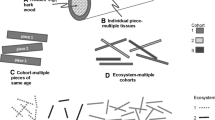Abstract
A search for surrogate variables of weather's control over rate of decay by decomposer organisms has revealed that Actual Evapotranspiration (AE), a water budget term, correlates well (r = 0.976) with measured values of litter decomposition rate. Using data from many biomes of the earth, a curve-fit of AE with measured decomposition rate has been formulated. This curve-fit has been used to prepare a map which displays the geography of predicted decay rate for North America. The physical properties of the litter also controls decomposition rates. Work is in progress to refine the AE to decomposer relationship by considering the lignin content of decomposing litter. Preliminary results suggest that control of decomposition rates by lignin increases with AE so that in high AE environments small changes in lignin concentration result in large changes in litter decay rates. This relationship perhaps explains the great variability in decay rates reported in tropical ecosystems.
Similar content being viewed by others
References
BENOIT, R. E., CAMPBELL, W. B. and HARRIS, R. W. (1972): Decomposition of organic matter in the wet meadow tundra. Barrow; a revised world model. Proceedings 1972 Tundra Biome Symposium, S. Bowen (ed.) CRREL, Hanover, New Hampshire, 111–115.
BERNHARD, F. (1970): Etude de la litière et de sa contribution au cycle des éléments minéraux en forêt ombrophile de Côte d'Ivorie. Oecol. Plant., 5: 247–266.
BUNNEL, F. L., TAIT, D. E. N., FLANAGAN, P. W. and VAN CLEVE, K. (1977): Microbial respiration and substrate weight loss, I: A general model of the influences of abiotic variables. Soil Biol. Biochem., 9: 33–40.
CROMACK, K. Jr. (1973): Litter production and decomposition in a mixed hardwood watershed and in a white pine watershed at Coweeta Hydrologic Station, North Carolina. Ph.D. Thesis. University of Georgia, Athens, GA.
CROSSLEY, D. A. Jr. and WITKAMP, M. (1964): Effects of pesticide on biota and breakdown of forest litter. Trans. Int. Cong. Soil Sci. 8th (Bucharest Romania). Publ. House of Acad. III: 887–892.
HAYES, A. J. (1966): Studies on the decomposition of coniferous leaf litter. J. Soil Science, 16: 121–139.
HOPKINS, B. (1966): Vegetation of the Olokemeji Forest Reserve, Nigeria IV. The litter and soil with special reference to their seasonal change. J. Ecol., 45: 687–703.
JOHN, D. M. (1973): Accumulation and decay of litter and net production of forest in tropical West Africa. Oikos, 24: 430–435.
LAUDELOUT, H. and MEYER, J. (1955): Les cycles d'éléments minéraux et de matière organique én forêt équatoriale congolaise. In: 5th Int. Congress Soil Science 2: General Secretary's Office, Bruxelles, 267–272.
MACK, R. N. (1977): Mineral return via the litter ofArtemisia tridentata. Amer. Midland Nat., 97: 189–197.
MADGE, D. S. (1965): Leaf fall and litter disappearance in a tropical forest. Pedobiologia, 5: 273–288.
MEENTEMEYER, V. (1974): Climatic water budget approach to forest problems. II. The prediction of regional differences in decomposition rate of organic debris. Pub. Climatol., 27: 35–74.
MEENTEMEYER, V. and ELTON, W. (1977): The potential implementation of biogeochemical cycles in biogeography. Professional Geog., 29: 266–271.
MIKOLA, P. (1960): Comparative experiments on decomposition rates of forest litter in Southern and Northern Finland. Oikos, 11: 161–166.
OLSON, J. S. (1963): Energy storage and the balance of producers and decomposers in ecological systems. Ecology, 44: 322–331.
SHANKS, R. E. and OLSON, J. S. (1961): First-year breakdown of leaf litter in Southern Appalachïan forests. Science, 134: 194–195.
THOMAS, W. A. (1968): Decomposition of Loblolly Pine needles with and without addition of Dogwood leaves. Ecology, 49: 568–571.
THOMAS, W. A. (1969): Accumulation and cycling of calcium by Dogwood trees. Ecol. Monogr., 39: 101–120.
THOMAS, W. A. (1970): Weight and calcium losses from decomposing tree leaves on land and in water. J. appl. Ecol., 7: 237–241.
THORNTHWAITE, C. W. and MATHER, J. R. (1955): The water balance. Pub. Climatol. 8: 86 pp.
VAN CLEVE, K. (1974): Organic matter quality in relation to decomposition. In: Soil Organisms and Decomposition in Tundra. A. J. Holding et al. (ed.) Tundra Biome Steering Committee, Stockholm, Sweden, 311–324.
VAN DER DRIFT, J. (1963): The disappearance of litter in mull and mor in connection with weather conditions and the activity of the macrofauna. In: Soil Organisms. J. Doeksen and J. Van der Drift (ed.) North-Holland Publishing Company, Amsterdam, 124–132.
WIANT, H. V. (1967a): Influence of temperature on rate of “soil respiration”. J. For., 65: 489–490.
WIANT, H. V. (1967b): Influence of moisture content on “soil respiration”. J. For., 65: 902–903.
WIDDEN, P., NEWELL, T., PARKINSON, D. (1972): Decomposition and microbial populations of Truelove Lowland. Devon Island. Devon Island I.B.P. Project, High Arctic Ecosystem Project Report 1970 and 1971. L. C. Bliss, (ed.). Dept. Botany, University of Alberta, Edmonton, Alberta, 341–358.
WITKAMP, M. (1966): Decomposition of leaf litter in relation to environment, microflora and microbial respiration. Ecology, 47: 194–201.
WITKAMP, M. and FRANK, M. L. (1969): Loss of weight,60co and137cs from tree litter in three subsystems of a watershed. Environ. Sci. Tech., 3: 1195–1198.
WITKAMP, M. and OLSON, J. S. (1963): Breakdown of confined and nonconfined oak litter. Oikos, 14: 138–147.
Author information
Authors and Affiliations
Rights and permissions
About this article
Cite this article
Meentemeyer, V. An approach to the biometeorology of decomposer organisms. Int J Biometeorol 22, 94–102 (1978). https://doi.org/10.1007/BF01552888
Received:
Issue Date:
DOI: https://doi.org/10.1007/BF01552888




